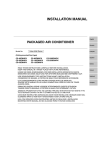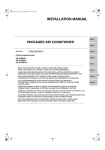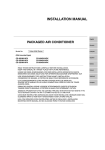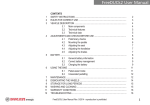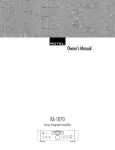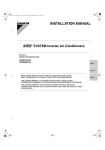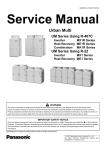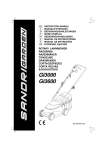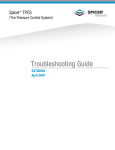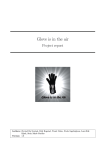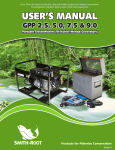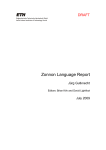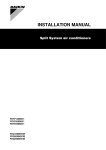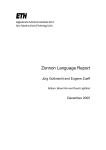Download INSTALLATION MANUAL
Transcript
INSTALLATION MANUAL English PACKAGED AIR CONDITIONER Deutsch Model No. Urban Multi Series Français (Ceiling-mounted cassete Corner type) CS-25DM1HPK CS-32DM1HPK CS-40DM1HPK CS-63DM1HPK Español Italiano READ THESE INSTRUCTIONS CAREFULLY BEFORE INSTALLATION. KEEP THIS MANUAL IN A HANDY PLACE FOR FUTURE REFERENCE. ÅëëçíéêÜ LESEN SIE DIESE ANWEISUNGEN VOR DER INSTALLATION SORGFÄLTIG DURCH. BEWAHREN SIE DIESE ANLEITUNG FÜR SPÄTERE BEZUGNAHME GRIFFBEREIT AUF. LIRE SOIGNEUSEMENT CES INSTRUCTIONS AVANT L’INSTALLATION. CONSERVER CE MANUEL A PORTEE DE MAIN POUR REFERENCE ULTERIEURE. LEA CUIDADOSAMENTE ESTAS INSTRUCCIONES ANTES DE INSTALAR. GUARDE ESTE MANUAL EN UN LUGAR A MANO PARA LEER EN CASO DE TENER ALGUNA DUDA. PRIMA DELL’INSTALLAZIONE LEGGERE ATTENTAMENTE QUESTE ISTRUZIONI. TENERE QUESTO MANUALE A PORTATA DI MANO PER RIFERIMENTI FUTURI. ÄÉÁÂÁÓÔÅ ÐÑÏÓÅÊÔÉÊÁ ÁÕÔÅÓ ÔÉÓ ÏÄÇÃÉÅÓ ÐÑÉÍ ÁÐÏ ÔÇÍ ÅÃÊÁÔÁÓÔÁÓÇ Å×ÅÔÅ ÁÕÔÏ ÔÏ ÅÃ×ÅÉÑÉÄÉÏ ÅÕÊÁÉÑÏ ÃÉÁ ÍÁ ÔÏ ÓÕÌÂÏÕËÅÕÅÓÔÅ ÓÔÏ ÌÅËËÏÍ. LEES DEZE INSTRUCTIES ZORGVULDIG DOOR VOOR INSTALLATIE. BEWAAR DEZE HANDLEINDING WAAR U HEM KUNT TERUGVINDEN VOOR LATERE NASLAG. LEIA COM ATENÇÃO ESTAS INSTRUÇÕES ANTES DE REALIZAR A INSTALAÇÃO. MANTENHA ESTE MANUAL AO SEU ALCANCE PARA FUTURAS CONSULTAS. Nederlands Portugues CONTENTS 1. 2. 3. 4. 5. 6. 7. 8. 9. 10. 11. SAFETY CONSIDERATIONS ........................................................................................ 1 BEFORE INSTALLATION .............................................................................................. 2 SELECTING INSTALLATION SITE ............................................................................... 4 PREPARATIONS BEFORE INSTALLATION................................................................. 5 INDOOR UNIT INSTALLATION ..................................................................................... 6 REFRIGERANT PIPING WORK .................................................................................... 7 DRAIN PIPING WORK................................................................................................... 9 ELECTRIC WIRING WORK ......................................................................................... 10 WIRING EXAMPLE AND HOW TO SET THE REMOTE CONTROLLER ................... 12 DECORATION PANEL INSTALLATION ...................................................................... 17 TEST OPERATION ...................................................................................................... 17 1. SAFETY CONSIDERATIONS Please read these “SAFETY CONSIDERATIONS” carefully before installing air conditioning equipment and be sure to install it correctly. After completing the installation, make sure that the unit operates properly during the start-up operation. Please instruct the customer on how to operate the unit and keep it maintained. Also, inform customers that they should store this installation manual along with the operation manual for future reference. This air conditioner comes under the term “appliances not accessible to the general public”. Meaning of warning and caution symbols. WARNING ........Failure to observe a warning may result in death. CAUTION ..........Failure to observe a caution may result in injury or damage to the equipment. • • • • • • • • 1 WARNING Ask your dealer or qualified personnel to carry out installation work. Do not try to install the machine yourself. Improper installation may result in water leakage, electric shocks or fire. Perform installation work in accordance with this installation manual. Improper installation may result in water leakage, electric shocks or fire. Be sure to use only the specified accessories and parts for installation work. Failure to use the specified parts may result in water leakage, electric shocks, fire or the unit falling. Install the air conditioner on a foundation strong enough to withstand the weight of the unit. A foundation of insufficient strength may result in the equipment falling and causing injuries. Carry out the specified installation work after taking into account strong winds, typhoons or earthquakes. Improper installation work may result in the equipment falling and causing accidents. Make sure that a separate power supply circuit is provided for this unit and that all electrical work is carried out by qualified personnel according to local laws and regulations and this installation manual. An insufficient power supply capacity or improper electrical construction may lead to electric shocks or fire. Make sure that all wiring is secured, the specified wires and used, and no external forces act on the terminal connections or wires. Improper connections or installation may result in fire. When wiring the power supply and connecting the wiring between the indoor and outdoor units, position the wires so that the switch box cover can be securely fastened. Improper positioning of the switch box cover may result in electric shocks, fire or the terminals overheating. English • If the refrigerant gas leaks during installation, ventilate the area immediately. Toxic gas may be produced if the refrigerant gas comes into contact with fire. • After completing the installation work, check that the refrigerant gas does not leak. Toxic gas may be produced if the refrigerant gas leaks into the room and comes into contact with a source of fire, such as a fan heater, stove or cooker. • Before touching electrical parts, turn off the unit. • • • • • • CAUTION Ground the air conditioner. Do not connect the ground wire to gas or water pipes, lightning conductor or a telephone ground wire. Incomplete grounding may result in electric shocks. Be sure to install an earth leakage breaker. Failure to install an earth leakage breaker may result in electric shocks. While following the instructions in this installation manual, install drain piping in order to ensure proper drainage and insulate piping in order to prevent condensation. Improper drain piping may result in water leakage and property damage. Install the indoor and outdoor units, power cord and connecting wires at least 1 meter away from televisions or radios in order to prevent image interference or noise. (Depending on the radio waves, a distance of 1 meter may not be sufficient enough to eliminate the noise.) Remote controller (wireless kit) transmitting distance can result shorter than expected in rooms with electronic fluorescent lamps. (inverter or rapid start types) Install the indoor unit as far away from fluorescent lamps as possible. Do not install the air conditioner in the following locations: (a) where a mineral oil mist or an oil spray or vapor is produced, for example in a kitchen Plastic parts may deteriorate and fall off or result in water leakage. (b) where corrosive gas, such as sulfurous acid gas, is produced Corroding copper pipes or soldered parts may result in refrigerant leakage. (c) near machinery emitting electromagnetic waves Electromagnetic waves may disturb the operation of the control system and result in a malfunction of the equipment. (d) where flammable gases may leak, where there are carbon fiber or ignitable dust suspensions in the air, or where volatile flammables such as thinner or gasoline are handled. Operating the unit in such conditions may result in fire. 2. BEFORE INSTALLATION • Decide upon a line of transport. • Leave the unit inside its packaging while moving, until reaching the installation site. Use a sling of soft material, where unpacking is unavoidable or protective plates together with a rope when lifting, to avoid damage or scratches to the unit. • Refer to the installation manual of the outdoor unit for items not described in this manual. 2-1 PRECAUTIONS • Be sure to read this manual before installing the indoor unit. • Entrust installation to the place of purchase or a qualified serviceman. Improper installation could lead to leaks and, in worse cases, electric shock of fire. • When installing the unit in a small room, take measures against to keep refrigerant concentration from exceeding allowable safety limits in the event of refrigerant leakage. Contact the place of purchase for more information. Excessive refrigerant in a closed ambient can lead to oxygen deficiency. • Use only parts provided with the unit or parts satisfying required specifications. Unspecified parts could cause the unit to fall out of place, or could lead to leaks and, in worse cases, electric shock or fire. • Do not install or operate the unit in rooms mentioned below. English 2 • Laden with mineral oil, or filled with oil vapor or spray like in kitchens. (Plastic parts may deteriorate which could eventually cause the unit to fall out of place, or could lead to leaks.) • Where corrosive gas like sulfurous gas exists. (Copper tubing and brazed spots may corrode which could eventually lead to refrigerant leaks.) • Where exposed to combustible gases and where volatile flammable gas like thinner or gasoline is used. (Gas in the vicinity of the unit could ignite.) • Where machines can generate electromagnetic waves. (Control system may malfunction.) • Where the air contains high levels of salt such as that near the ocean and where voltage fluctuates greatly such as that in factories. Also in vehicles or vessels. • When selecting installation site, refer to the paper pattern. • This unit, both indoor and outdoor, is suitable for installation in a commercial and light industrial environment. If installed as a household appliance it could cause electromagnetic interference. 2-2 ACCESSORIES Check the following accessories are included with your unit. Name Clamp metal Paper pattern for installation Drain hose Insulation for fitting Sealing pad Drain raising pipe Drain pipe insulation Quantity Large and small 1 each 1 1 1 set Large and small 1 each 1 1 For gas pipe Large For liquid pipe Small Shape Corrugated cardboard Name Insulation for hanger bracket Washer for hanging bracket Clamp Positioning jig for installation Air outlet blocking pad Quantity 4 8 7 2 each 1 Shape (Other) • Operation manual • Installation manual 4 screws • Screws for fixing panels are attached to air inlet panel. 2-3 OPTIONAL ACCESSORIES • The optional decoration panel and remote controller are required for this indoor unit. Model CS-25 · 32 · 40DM1HPK CS-63DM1HPK Min. height above ceiling 22 cm or more Air inlet panel Color White CZ-02KPD11P CZ-03KPD11P • These are two types of remote controllers: wired and wireless. Select a remote controller from the Table 1 according to customer request and install in an appropriate place. Table 1 Remote controller Wired type Wireless type (Separate type) Model No. CZ-01RT11P Heat pump type Cooling only type CZ-02RWD12P – NOTE • If the customer wish to use a remote controller that is not listed in Table 1, select a suitable remote controller after consulting catalogs and technical materials. 3 English FOR THE FOLLOWING ITEMS, TAKE SPECIAL CARE DURING CONSTRUCTION AND CHECK AFTER INSTALLATION IS FINISHED. Items to be checked after completion of work Items to be checked If not properly done, what is likely to occur Is the indoor unit fixed firmly? The unit may drop, vibrate or make noise. Is the gas leak test finished? It may result in insufficient cooling. Is the unit fully insulated? Condensate water may drip. Does drainage flow smoothly? Condensate water may drip. Does the power supply voltage correspond to that shown on the name plate? The unit may malfunction or the components burn out. Are wiring and piping correct? The unit may malfunction or the components burn out. Is the unit safely grounded? Dangerous at electric leakage. Is wiring size according to specifications? The unit may malfunction or the components burn out. Is something blocking the air outlet or inlet of either the indoor or outdoor units? It may result in insufficient cooling. Are refrigerant piping length and additional refrigerant charge noted down? The refrigerant charge in the system is not clear. Check 2-4 NOTES TO THE INSTALLER • Read this manual carefully to ensure correct installation. Be sure to instruct the customer how to operate the system showing him/her the enclosed operation manual. • Explain to the customer what system is installed on the site and be sure to fill in what is required in the column shown on “WHAT TO DO BEFORE OPERATION” of the operation manual. 3. SELECTING INSTALLATION SITE 20 cm or more English 100 cm or more (1) Select an installation site where the following conditions are satisfied and that meets with your customer’s approval. • Where optimum air distribution can be ensured. • Where nothing blocks air passage. • Where condensate can be properly drained. • Where the ceiling is strong enough to bear the indoor unit weight. • Where the false ceiling is not noticeably on an incline. • Where sufficient clearance for installation and maintenance can be ensured. • Where piping between indoor and outdoor units is possible within the allowable limit (Refer to the installation manual for the outdoor unit.) • Keep the indoor and outdoor units, power cable and transmission wiring, at least 1 m from TVs and radios, to prevent distorted pictures and static. (Depending on the type and source of the electrical waves, static may be heard even when more than 1 m away.) 20 cm or more 4 (2) Ceiling height This unit can be installed in ceilings up to 3.8 meters high. If the ceiling height exceeds 2.7 meters, however, the connector of terminal board (A2P) must be replaced and an air outlet blocking pad must be installed. See HIGH CEILING INSTALLATION (P.13). 22 cm or more (3) If you feel there is danger as a result of investigating whether the place you want to install the unit can hold its weight, reinforce with a board or beam, etc., before installing. (Because installation pitch is recorded on the paper pattern for installation, check wheter reinforcement will be required or not along with referring to the paper pattern.) 150 cm or more 2 cm or more (Discharge side) (Suction side) 4. PREPARATIONS BEFORE INSTALLATION (1) Relation of ceiling opening to suspension bolt position A B C D CS-25 · 32 · 40DM1HPK 1110 1150 1200 1240 CS-63DM1HPK 1310 1350 1400 1440 Decoration panel 800 760 710 350 Model Ceiling opening Indoor unit Suspension bolt 4 A B C D (2) Open a hole in the ceiling for installation. (Case of existing ceiling) • Use the paper pattern for installation which has been adjusted to the dimensions of the ceiling opening. • Open a hole in the ceiling for installation at the place the unit is to be installed, and run refrigerant and drain piping, remote controller cord, and outdoor/indoor transmission wiring to the unit’s piping and wiring hole. (For wiring procedure, refer to “WIRING EXAMPLE AND HOW TO SET THE REMOTE CONTROLLER.” For piping procedure, refer to the attached installation manual of the outdoor unit.) • After opening a hole in the ceiling, reinforcement of the ceiling frame, etc., may be required to maintain the levelness of the ceiling and to prevent vibration of the ceiling. For details, consult with your builder and interior contractor. 〈Set-up example〉 Approx. 100 mm Ceiling slab Anchor Wing nut or turnbuckle Suspension bolt Ceiling surface Note) All parts shown in the figure above are field supplied parts. 5 English (3) Install the suspension bolts. (Use M8 size suspension bolts.) Use anchors for existing ceilings and embedded inserts, embedded anchors, etc., for newly built ceilings so that the weight of the unit can be supported. Adjust the length of the bolts to the ceiling before installing the unit. 5. INDOOR UNIT INSTALLATION 〈〈When installing optional accessories (except for the air inlet panel), read also the installation manual for optional accessories. Depending on the field conditions, it may be easier to install optional accessories before the indoor unit is installed.〉〉 (1) Install the unit temporarily. • Fix the hanger bracket to the suspension bolt. Tighten both upper and lower nuts firmly using washers. Part to be procured in the field Attached with unit Tighten from above and below (Double nut) (2) Using the attached positioning jig for installation, adjust the height of the unit. (3) Adjust the unit to the correct position based on “SELECTING INSTALLATION SITE.” (1). • The positioning jig for installation and paper pattern for installation have been adjusted to the dimensions of the ceiling opening. Be sure to establish thorough communication with those who are to do the ceiling work. Positioning jig for installation 1 (Attached) Positioning jig for installation 2 Positioning jig for installation 2 (Attached) (Attached) Screw (4 attached screws) Positioning jig for installation 1 (Attached) Positioning jig for installation fastening screw hole Lower surface of ceiling (4) Check the unit is horizontally level. • The unit is equipped with a built-in drain pump and float switch. Level the four corners with a conventional level or a vinyl tube containing water. (If the unit is tilted against condensate flow, the float switch may malfunction and cause water to drip.) Water level (5) Tighten the upper nut. Vinyl tube (6) Apply the attached insulation for hanger bracket to the hanger bracket installation bolts of the units. (4 locations). (See figure on right.) (7) After setting up the unit, be sure to remove the positioning jig for installation. NOTE • For a newly built ceiling, carry out the same procedure and be sure to establish thorough communication with those who are to do the ceiling work. The positioning jig for installation and paper pattern for installation have been adjusted to the dimensions of the ceiling opening. English Insulation for hanger bracket 6 6. REFRIGERANT PIPING WORK 〈For refrigerant piping of outdoor units, see the installation manual attached to the outdoor unit.〉〉 〈Be sure to thermally insulate both the gas pipes and fluid pipes. Water leakage may result if the pipes are not insulated. (Only use insulation resistant to at least 120 °C.) Furthermore, if the temperature/humidity in the refrigerant piping are expected to exceed 30 °C or 80% RH, the thermal insulation of the refrigerant pipes should be strengthened (to be a thickness of 20 mm or more). There may be some condensation on the surface of the insulation material.〉〉 〈Before rigging tubes, check which type of refrigerant is used. Proper operation is not possible if the types of refrigerant are not the same.〉〉 6-1 CAUTION • Use a pipe cutter and flare suitable for the type of refrigerant. • Apply ester oil or ether oil around the flare portions before connecting. • To prevent dust, moisture or other foreign matter from infiltrating the tube, either pinch the end or cover it with tape. • The outdoor unit is charged with refrigerant. • Be sure to use both a spanner and torque wrench together, as shown in the drawing, when connecting or disconnecting pipes to/from the unit. • Refer to the Table 2 for flare measurements. • When connecting the flare nut, coat the flare both inside and outside with refrigerating machine oil and initially tighten by hand 3 or 4 turns before tightening firmly. • Refer to the Table 2 for tightening torque. Overtightening may damage the flare. • Check the pipe connector for gas leaks, then insulate it as shown in the drawing. • Wrap only the gas line side with the sealing pad. Bend the pad over the insulation for fitting (union) from above. Clamp (× 6 attached) Torque wrench Coated with ester oil or ether oil. Small sealing pad (attached) Spanner Flare nut Piping union Insulation for fitting (attached) Gas pipe Liquid pipe CAUTION Overtightening may damage the flare and cause leaks. Use “ Tabel 3 ” as a reference if a torque wrench is not available. Once work is complete, make sure there is no gas leaking. As the flare nut is tightened with the wrench, the torque will suddenly increase. From that position, tighten the nut to the angle shown on “ Tabel 3 ”. • Make absolutely sure to execute heat insulation works on the pipe-connecting section after checking gas leakage by thoroughly studying the following figure and using the attached heat insulating materials for fitting (6) and (7). (Fasten both ends with the clamps (4) (attached).) • Wrap the sealing pad (9) (attached) only around the insulation for the joints on the gas piping side. CAUTION Be sure to insulate any field piping all the way to the piping connection inside the unit. Any exposed piping may cause condensation or burns if touched. • When brazing the refrigerant piping, only begin brazing after having carried out nitrogen substitution (NOTE 1) or while inserting nitrogen into the refrigerant piping (NOTE 2). Once this is done, connect the indoor unit with a flared or a flanged connection. NOTES 1. Refer to the “Manual for Multi Installation for Buildings” for directions on how to carry out nitrogen substitution. (Inquire with your dealer.) 7 English 2 2. Nitrogen should be set to 0.02 Mpa (0.2 kg/cm ) with a pressure-reducing valve if brazing while inserting nitrogen into the piping. Pressure-reducing valve Refrigerant piping Part to be brazed Taping hands valve Nitrogen Nitrogen The flare nuts used must be those included with the main body. • Refer to Table 2 for tightening torque. Table 2 φ 9.5 32.7 – 39.9N·m (333 – 407 kgf·cm) 12.6 – 13.0 φ 12.7 49.5 – 60.3N·m (504 – 616 kgf·cm) 15.8 – 16.2 φ 15.9 61.8 – 75.4N·m (630 – 770 kgf·cm) 19.0 – 19.4 φ 19.1 97.2 – 118.6N·m (990 – 1210 kgf·cm) 23.3 – 23.7 0 8.6 – 9.0 0 90 Ⳳ0.5 R0.4-0.8 A 14.2 – 17.2N·m (144 – 176 kgf·cm) 0 φ 6.4 Flare shape 0 Flare dimension A (mm) 45 Ⳳ 2 Tightening torque Pipe gauge Not recommendable but in case of emergency You must use a torque wrench but if you are obliged to install the unit without a torque wrench, you may follow the installation method mentioned below. After the work is finished, make sure to check that there is no gas leak. When you keep on tightening the flare nut with a spanner, there is a point where the tightening torque suddenly increases. From that position, further tighten the flare nut the angle shown below: Table 3 Pipe size Further tightening angle Recommended arm length of tool φ 6.4 (1/4”) 60 to 90 degrees Approx. 150mm φ 9.5 (3/8”) 60 to 90 degrees Approx. 200mm φ 12.7 (1/2”) 30 to 60 degrees Approx. 250mm φ 15.9 (5/8”) 30 to 60 degrees Approx. 300mm φ 19.1 (3/4”) 20 to 35 degrees Approx. 450mm English 8 7. DRAIN PIPING WORK the drain pipe as shown below and take measures 〈〈Rig 〈〈 against condensation. Improperly rigged piping could lead to leaks and eventually wet furniture and belongings.〉〉 〉〉 Clamp metal Attached drain raising pipe Clamp metal Drain hose Clamp metal (Attached with unit) Large sealing pad (Attached with unit) Drain hose 4mm or less Ceiling slab Max. 500 mm Adjustable Supporting bracket 200 mm 1 ~ 1.5 mm 170 mm (1) Install the drain pipes. • Keep piping as short as possible and slope it downwards so that air may not remaine trapped inside the pipe. • Keep pipe size equal to or greater than that of the connecting pipe (Vinyl pipe of 25 mm nominal diam. and 32 mm outer diam.) • Use the attached drain hose and clamp metal. Insert the drain hose all the way into the drain socket and fasten securely with a clamp on the part of the hose with white tape. Tighten the clamp screw until the inference is no more than 4 mm. • Be sure to insulate the following two items in order to prevent water leakage caused by condensation. • Indoors darin piping • Drain socket While referring to the figure on the right, insulate the clamp and drain hose with the attached large sealing pad. • If the drain hose cannot be sufficiently set on a slope, fit the hose with drain raising piping as Attached shown in the drawing. insulation Be sure to use the attached drain hose, drain raising pipe, clamp and drain pipe insulation. • Secure a downward gradient of 1/100 or more for the drain pipe. To accomplish this, mount supporting brackets at an interval of 1 - 1.5 m. Attached drain hose Clamp metal 100 mm or more • Use the following outline if layDrain pipe ing central drain piping. 〈Drain raising pipe laying procedure〉〉 Central drain pipe (1) Connect the drain raising pipe and drain hose and fasten with a clamp. (2) Mount the drain pipe insulation and wrap with vinyl tape. (3) After completing steps (1) and (2), attach the drain raising pipe to the drain pipe connection port of the indoor unit and fasten with a clamp. (Do not connect any other pipes between the drain raising pipe and the indoor unit.) • Adjust the drain raising height by turning the drain raising pipe as shown in the figure. (2) After piping, check to make sure draining flows smoothly. If construction work for interconnecting piping is complete: Using a plastic container for water filling, etc., gradually inject about 1,000 cc of water into the drain pan through the inspection hatch. NOTE • To drain water from the drain pan, use the drainage port for maintenance. Inspection hatch Drainage port for maintenance (With rubber cap) Plastic container for water filling 9 English WHEN ELECTRIC WIRING WORK IS FINISHED • Check drainage flow during COOL running, explained under “TESTOPERATION”. WHEN ELECTRIC WIRING WORK IS NOT FINISHED • Remove the electric parts box lid, connect a power supply and remote controller to the terminals. (Refer to the HOW TO CONNECT WIRINGS (P.12)) Next, press the inspection/test operation button “ TEST ” on the remote controller. The unit will engage the test operation mode. Press the operation mode selector button “ Then, press the ON/OFF button “ has drained from the unit. Press “ ” until selecting FAN OPERATION “ ”. ”. The indoor unit fan and drain pump will start up. Check that the water TEST ” to go back to the first mode. L N Power supply TYPE ~220-240V PC board Power supply terminal Copper wire Electric parts box lid. CAUTION Drain piping connections Do not connect the drain piping directly to sewage pipes that smell of ammonia. The ammonia in the sewage might enter the indoor unit through the drain pipes and corrode the heat exchanger. 8. ELECTRIC WIRING WORK 8-1 GENERAL INSTRUCTIONS • All field supplied parts and materials, electric works must conform to local codes. • Use copper wire only. • Follow the “WIRING DIAGRAM” attached to the unitbody to wire the outdoor unit, indoor units and the remote controller. For details on hooking up the remote controller, refer to the “INSTALLATION MANUAL OF REMOTE CONTROLLER.” • All wiring must be performed by an authorized electrician. • This system consists of multiple indoor units. Mark each indoor unit as unit A, unit B …, and be sure the terminal board wiring to the outdoor unit and HR box are properly matched. If wiring and piping between the outdoor unit and an indoor unit are mismatched, the system may cause a malfunction. • A circuit breaker capable of shutting down the power supply to the entire system must be installed. English 10 8-2 ELECTRICAL CHARACTERISTICS Units Model Power supply Hz Volts Voltage range CS-25 · 32DM1HPK CS-40DM1HPK 50 Max. 264 Min. 198 220-240 CS-63DM1HPK MCA: Min. Circuit Amps (A); kW: Fan Motor Rated Output (kW); Fan motor MCA MFA kW FLA 0.3 15 0.015 0.2 0.3 15 0.020 0.2 0.5 15 0.045 0.4 MFA: Max. Fuse Amps (A) FLA: Full Load Amps (A) 8-3 SPECIFICATIONS FOR FIELD SUPPLIED FUSES AND WIRE Power supply wiring Transmission wiring Model Field fuses Wire Size Wire Size H05VV-U3G Wire size must comply with local codes. Vinyl cord with sheath or cable (2 wire) (NOTE 2) 0.75 - 1.25 mm2 CS-25 · 32DM1HPK CS-40DM1HPK 15A CS-63DM1HPK NOTES 1. Allowable length of transmission wiring between indoor/outdoor units and between the indoor unit and the remote controller is as follows. (1) Outdoor unit – Indoor unit: Max. 1000 m (Total wiring length: 2000 m) (2) Indoor unit – Remote controller: Max. 500 m 2. Insulated thickness:1 mm or more 11 English 9. WIRING EXAMPLE AND HOW TO SET THE REMOTE CONTROLLER 9-1 HOW TO CONNECT WIRINGS • Refer to the figure below when connecting the remote controller wiring with transmission wiring and power supply wiring NOTE 1: Details of terminal block for power supply Electric parts box Attached clamp Power supply terminal board (NOTE 1) Ground wire (∗) Plastic clamp Wiring berween units (∗) Remote controller wire and connecting wire (∗) LN Electric parts box Wire clip Power supply wiring (Field wiring) NOTE 2: Details of terminal board for unit transmission wirings Remote controller wiring (Field wiring) Plastic clamp Transmission wiring between units (Field wiring) Rubber bush Terminal board for unit transmission wirings Electric parts box lid T2 T1 F2 F1 P2 P1 (NOTE 2) Clamp (Attached) Electric parts box • You can temporarily hang the electric parts box of the unit from the position shown in the figure below. Use according to the type of work. CAUTION • When cramping wiring, use the included cramping material to do an appropriate cramp to prevent undue pressure on the wiring connections. When carrying out the wiring, bundle the wires to prevent the switch box lid from lifting, and attach the lid firmly. When attaching the switch box avoid getting wires caught always use a wiring through-lid to prevent damage to the wires. • Make sure to avoid external force to the field wiring(∗) such as by laying them in protection pipes or in the wall. English 12 [ PRECAUTIONS ] 1. Use ring-type crimp-style terminals for connecting Ring-type crimp style terminal wires to the power supply terminal board. If unavailable, observe the following points when wiring. Electric • Do not connect wires of different gauge to the wire same power supply terminal. (Looseness in the connection may cause overheating.) Connect wires of Do not connect Do not connect the same gauge to wires of the same wires of different • When connecting wires of the same gauge, conboth sides. gauge to one side. gauges. nect them according to the righthand figure. • Use the specified electric wire. Connect the wire securely to the terminal. Lock the wire down without applying excessive force to the terminal. (Tightening torque: 1.31N · m ± 10%) 2. Keep total current of crossover wiring between indoor units less than 12 A. Branch the line outside the terminal board of the unit in accordance with electrical equipment standards, when using two power wiring of a gauge greater than 2 mm2 (φ1.6). The branch must be sheathed to provide an equal or greater degree of insulation as the power supply wiring itself. 3. Do not connect wires of different gauge to the same grounding terminal. Looseness in the connection may deteriorate protection. 4. Keep transmission wiring at least 50 mm away from power supply wiring. The equipment may malfunction if subjected to electrical (external) noise. 5. For remote controller wiring, refer to the “INSTALLATION MANUAL OF REMOTE CONTROLLER” attached to the remote controller. 6. Never connect power supply wiring to the terminal board for transmission wiring. A mistake of the sort could damage the entire system. 7. Use only specified wire and tightly connect wires to terminals. Be careful wires do not place external stress on terminals. Keep wiring in neat order and so as not to obstruct other equipment such as popping open the service cover. Make sure the cover closes tight. Incomplete connections could result in overheating, and in worse case, electric shock or fire. 9-2 HIGH CEILING INSTALLATION X3A X2A NORMAL HIGH MIF MIF X1A X2A NORMAL HIGH PC board X1A Terminal board (A2P) X3A (1) This unit can be installed in ceilings up to 3.8 meters high. If the ceiling height exceeds 2.7 meters, however, connect the connector on the terminal board (A2P) of indoor units as shown in the figure below. (Factory set) (2) Match with setting of (1) and apply air outlet blocking pad. For CS-25 · 32 · 40DM1HPK • Apply to the left side drain pan opening (3 locations) as shown in the figure. Insert 13 English For CS-63DM1HPK • Apply to the right side drain pan opening (3 locations) as shown in the figure. Insert 9-3 WIRING EXAMPLE • Fit the power supply wiring of each unit with a switch and fuse as shown in the drawing. COMPLETE SYSTEM EXAMPLE (3 systems) Power supply Power supply wiring Outdoor unit Main switch Transmission wiring Switch Fuse HR box (Only for Heat recovery system) Indoor unit Remote controller 1. When using 1 remote controller for 1 indoor unit. (Normal operation) Power supply 220-240V Outdoor unit Power supply 220-240V Power supply 220-240V Power supply 220-240V Control box 50Hz or L N 220V IN/D OUT/D F1 F2 F 1 F2 No. 1 System 60Hz LN P 1 P 2 F 1 F2 T1 T 2 Indoor unit A 50Hz or 220V L N 60Hz LN P 1 P 2 F 1 F2 T 1 T 2 Indoor unit B P1 P2 English L N 50Hz or 220V 60Hz LN P 1 P 2 F1 F 2 T 1 T 2 Indoor unit C P 1 P2 L N 50Hz or 220V 60Hz LN P 1 P 2 F1 F 2 T 1 T 2 Most downstream indoor unit P 1 P2 P1 P2 14 2. For group control or use with 2 remote controllers Power supply 220-240V Outdoor unit Note: It is not necessary to designate indoor unit address when using group control. The address is automatically set when power is activated. Control box IN/D OUT/D F1 F2 F 1 F 2 50Hz or L N 220V No. 2 System 60Hz Indoor unit B Indoor unit A LN P1 P2 F1 F2 T1 T2 LN Indoor unit C P1 P2 F1 F2 T1 T2 LN P 1 P 2 F 1 F 2 T1 T2 LN P1 P 2 F1 F2 T1 T 2 P1 P 2 P1 P2 Most downstream indoor unit P1 P2 For use with 2 remote controllers 3. When including HR box Power supply 220-240V Outdoor unit Control box 50Hz or L N 220V IN/D OUT/D F1 F 2 F 1 F 2 HR box No. 3 System 60Hz LN Control box OUT/D IN/D F1 F 2 F1 F 2 P 1 P 2 F 1 F2 T 1 T 2 Indoor unit A P 1 P2 [ PRECAUTIONS ] 1. A single switch can be used to supply power to units on the same system. However, branch switches and branch circuit breakers must be selected carefully. 2. Do not ground the equipment on gas pipes, water pipes or lightning rods, or crossground with telephones. Improper grounding could result in electric shock. 9-4 CONTROL BY 2 REMOTE CONTROLLERS (Controlling 1 indoor unit by 2 remote controllers) • When using 2 remote controllers, one must be set to “MAIN” and the other to “SUB”. MAIN/SUB CHANGEOVER (1) Insert a wedge-head screwdriver into the recess between the upper and lower part of remote controller and, working from the 2 positions, remove carefully the upper part. The remote controller PC board is attached to the upper part of remote controller. Upper part of remote controller Lower part of remote controller Insert the screwdriver here and gently work off the upper part of remote controller. 15 English (2) Turn the MAIN/SUB changeover switch on one of the two remote controller PC boards to “S”. (Leave the switch of the other remote controller set to “M”.) (Factory setting) Only one remote controller needs to be changed if factory settings have remained untouched. S M Remote controller PC board S M 9-5 COMPUTERISED CONTROL (FORCED OFF AND ON/OFF OPERATION) (1) Wire specifications and how to perform wiring • Connect input from outside to terminals T1 and T2 of the terminal board (remote controller to transmission wiring). F2 T1 T2 FORCED OFF Input A Wire specification Sheathed vinyl cord or cable (2 wire) Gauge 0.75 - 1.25 mm2 Length Max. 100 m External terminal Contact that can ensure the minimum applicable load of 15 V DC, 10 mA. (2) Actuation • The following table explains FORCED OFF and ON/OFF OPERATIONS in response to Input A. FORCED OFF ON/OFF OPERATION Input “ON” stops operation (impossible by remote controllers). Input “OFF” → “ON” turns ON unit. Input “OFF” enables control by remote controller. Input “ON” → “OFF” turns OFF unit. (3) How to select FORCED OFF and ON/OFF OPERATION • Turn the power on and then use the remote controller to selet operation. • Set the remote controller to the field set mode. SECOND For details, refer to the “HOW TO SET IN THE CODE NO. FIELD”, in the remote controller manual. • When in the field set mode, select mode No. 12, then set the first code (switch) No. to “1”. Then set second code (position) No. to “01” for FORCED OFF and “02” for ON/OFF FIRST CODE OPERATION. (FORCED OFF at factory set) NO. 9-6 CENTRALIZED CONTROL Mode No. SETTING FIELD SET MODE • For centralized control, it is necessary to designate the group No. For details, refer to the manual of each optional controllers for centralized control. English 16 10. DECORATION PANEL INSTALLATION Refer to the installation manual of the panels. [ PRECAUTIONS ] • SWING FLAP MOTOR WIRING METHOD (1) CONNECT TWO LEAD WIRES OF SWING FLAP MOTOR MOUNTED ON THE DECORATION PANEL TO THE CONNECTORS OF MAIN BODY. (2) SLIDE THE INSULATION TUBE ACCORDING TO THE ARROW AS SHOWN IN FIG. SO THAT THE CONNECTOR CAN BE COMPLETELY COVERED. (ONLY HIGH VOLTAGE SIDE) (3) BIND THE OPENING OF INSULATION TUBE WITH THE ATTACHED CLAMP MATERIAL. CLAMP MATERIAL (ATTACHED PART) 11. TEST OPERATION Refer to the installation manual of the outdoor unit. • The operation lamp of the remote controller will flash when an error occurs. Check the error code on the liquid crystal display to identify the point of trouble. An explanation of error codes and the corresponding trouble is provided in “CAUTION FOR SERVICING” of the indoor unit. 17 English 3VA11509-1A EM01A155 (0110) HT



















